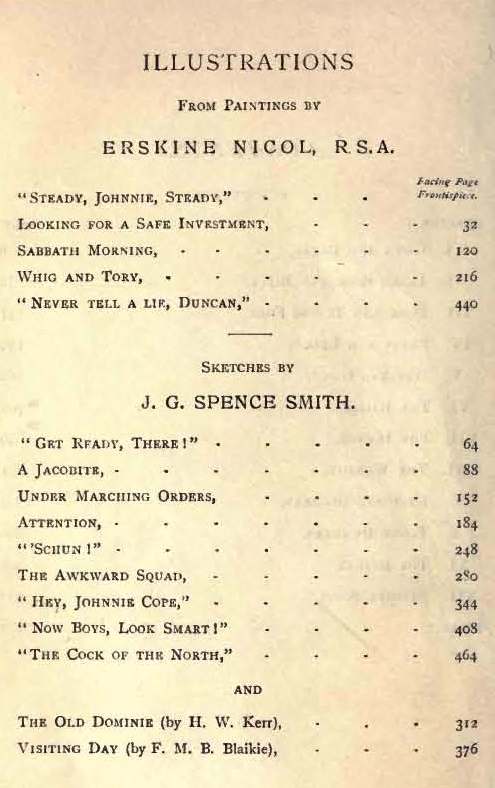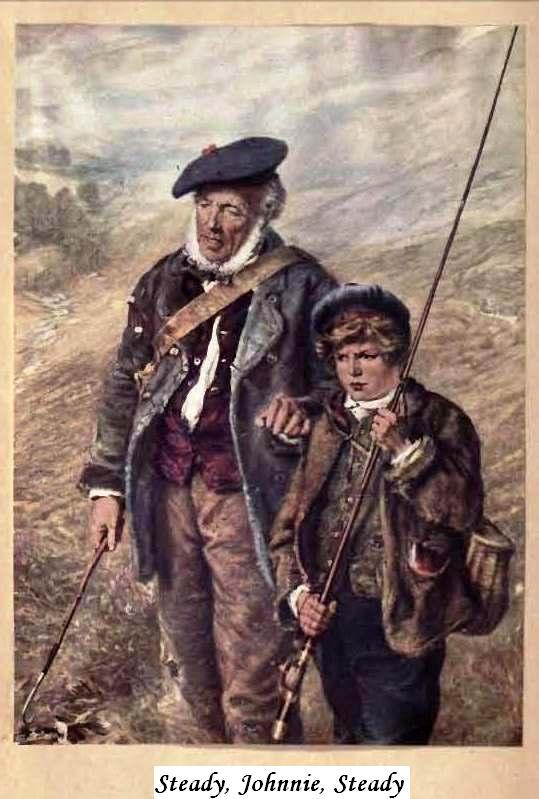|
WILLIAM HARVEY J.P. F.S.A. Scot.,
(1874, Stirling – 1936,
Dundee)
‘Son Of The Rock’
William Harvey was born on the
8th of June, 1874 in 44 Baker Street, Stirling, but the death there of
his Stirling born father, Charles Harvey [Coach Painter] from Pulmonary
Tuberculosis, on the 9th of September, 1874, aged 28, immediately put
the whole burden of rearing William and his elder sister Margaret
Galbraith Harvey (b. 25th of October, 1872 in Stirling) on to his 33
year old, Bo’ness born, mother, Helen (Robertson) Harvey.

In the 1881 Census, the family
appear thus ….
Dwelling: 4
Bank Street
1881 Census
Place: Stirling, Stirling, Scotland
Helen HARVEY, Head , Widow, aged 39, born Bo’ness,
Linlithgow, Scotland
Margaret HARVEY, Daughter, Scholar, aged 8, born Stirling, Stirling,
Scotland
William HARVEY,
Son, Scholar, aged 6, born Stirling, Stirling, Scotland
After having received what
schooling it was compulsory for him to take, William had to apply
himself to work, and, at eleven years of age, in 1885, he was
apprenticed to a hatter. On the expiry of his apprenticeship, which took
place in his early teens, he expressed a dislike for the occupation, and
so was apprenticed to a craft. He entered a large carriage-building
establishment at Stirling, and was initiated into the 'mysteries' of
coach-trimming.
In the 1891 Census, William is
alone with his mother, thus ..
1891 Scotland Census
Address: 4 Bank Street, Stirling
Helen Harvey, Head, aged 49, Widow, born Bo’ness,
Linlithgow, Scotland
William Harvey, Son, Coach Trimmer, aged 16, born Stirling, Stirling,
Scotland
Here, however, William was also
dissatisfied with this calling, and in his spare moments, while serving
this coach-trimmer apprenticeship, he engaged in the study of shorthand;
and, when just about to be considered a full-fledged tradesman, he was
offered a job in one of the principal law offices in Stirling, which he
accepted.
His first literary effort, around 1892, was an
essay on "Joseph," which he then entered in a competition sponsored by
the lst Stirling Company of the Boys' Brigade. His essay was awarded
first prize! Then, shortly afterwards, he began writing articles and
verses, most of which were published in the Stirling Sentinel. These
articles and poems, mostly of a legendary character, under the title
"Scottish Lays and Legends,” were followed by a series of essays dealing
with certain changes in Scottish Presbyterian worship, under the title
"Scotland’s Romeward Career.”
In 1893 he edited a volume by
David Taylor, the St. Ninians poet, which gained very favourable
receptions both at home and abroad. From 1894 onwards he contributed a
series of articles to the Stirling Journal and Advertiser concerning
poets who had either been born, or had, at some time, lived in
Stirlingshire. This completed work was published in 1897 under title
"The Harp of Stirlingshire? But meantime in the spring of 1896 he had
issued a book dealing with Scottish life and character, entitled "Kennethcrook;
Some Sketches of Village Life." [Most opinions suggest that the context
for this publication was the village of Cambuskenneth, just over the
River Forth to the east of Stirling.] Thereafter before the turn of the
century, he not only produced a collection of anecdotes on the same
subject entitled "Scotch Thistles”, but also a series of songs in the
vernacular, called " Doric Lilts.”
However, a significant event of
a different nature occurred in William’s life in Stirling in 1899 - He
became a Freemason when initiated in Stirling Royal Arch No. 76 in that
year. Thus, at this point in his story, it seems appropriate to record
his progress in Freemasonry up to his death in 1936, as well as the
titles of some of his published articles about Freemasonry completed
before his death in 1936 v.i.z.
Founder Member of Lodge 967 in
1904.
R.W.M. of Lodge 967
in 1914 to 1916.
Founder
Member of Lodge 1149 in 1915.
P.Z. of Royal Arch Chapter No. 421.
Provincial Grand Bard of Forfarshire 1915.
Founder Member of Lodge 1192 in 1919.
Sub Provincial Grand Master of Forfarshire.
Provincial Grand Master Depute of Forfarshire.
Right Worshipful Provincial Grand Master of
Forfarshire 1935
Articles
“THE ANCIENT SCOTTISH CRAFT and
the Third Degree”
“The
Altar of Freemasonry”
“THE
DEIL AMONG THE MASONS”
“The Wages of an Entered Apprentice”
“THE STORY OF HIRAM ABIFF”
“The Lodge and its Furniture”
“THE MASON’S APRON”
“Robert Burns and Masonry”
“THE MASON’S MALLET”
“The Third Degree In Freemasonry – Its Ornaments
and Emblems”
----------------------------------------------------------------------------------------
To return to William's life journey ....
As can be seen from the 1901
Census, he left Stirling to take up an appointment as a journalist in
Dundee before April, 1901 …
1901 Scotland Census
Name: William Harvey
Age: 26
Birth Year: 1874
Relationship: Son
Mother's Name: Helen [Robertson]
born Bo'ness
Gender: Male
Where born: Stirling,
Stirlingshire
Registration Number: 282/2
Registration district: St Mary
Civil parish: Liff and Benvie
County: Angus
Address: 55, Milnbank Road
Occupation: Journalist
Household Members:
Helen Harvey 59
William Harvey 26
Popular publications issued by
his printers up until his mother, Helen (Robertson) Harvey died aged 64
years in St Peter Dundee Angus in 1909, and with whom he had lived for
35 years, were,
The 164 page, “Scottish Chapbook
Literature” in 1903
and
the 544 page, “Irish Life And Humour” in 1909.
Then, in 1910 William married
Marjorie Annie Gray Mackay, and, in 1911, they were blessed with a son,
whom they named, William Robertson Harvey.

William clearly progressed in
his journalistic career as it is known that he soon became the editor of
a Dundee Newspaper. But this probably did not occur until after the
publication in 1911 of one of his most popular books, the 545 page opus,
“Scottish Life and Character in Anecdote and Story”. He clearly was a
highly regarded citizen when we note that he served as a Justice of the
Peace; and he must also have been well respected by his fellow
contributors to the arts when he was awarded a Fellowship of the
Scottish Society of Antiquaries. However, little appears to have been
recorded about the details of his life in the 1920s and 1930s …. apart
from his Freemasonry activities. The certificate of his premature death
on the 5th of July, 1936, following a coronary thrombosis, shows that he
had been predeceased by his wife Marjorie, but that he at least had had
the company of his son, William, at 11 Blackness Avenue in his latter
years.

Kennethcrook: Some
sketches of village life
By William Harvey (1896).
In 1893 William Harvey edited a
volume by David Taylor, the St Ninians poet, which gained very
favourable receptions both at home and abroad. From 1894 onwards he
contributed a series of articles to the Stilling Journal and Advertiser
concerning poets who had either been born, or had, at some time, lived
in Stirlingshire.
This completed work was published
in 1897 under title "The Harp of Stirlingshire? But meantime in the
spring of 1896 he had issued a book dealing with Scottish life and
character, entitled Kennethcrook: Some Sketches of Village Life."
[Most opinions suggest that the
context for this publication was the village of Cambuskenneth, just over
the River Forth to the east of Stirling.]
Contents
Note: These chapters are provided in adobe reader
format.
THE VILLAGE AND ITS WAYS.
THE VILLAGE CALENDAR.
Chapter I. The Village Calendar
Chapter II. The Fair
Chapter III. Hallowe'en
Chapter IV. Hogmanay
Chapter V. Handsel Monday
THE VILLAGE TRAGEDY.
Chapter I. Blighted Hopes
Chapter II. Forgiveness
Chapter III. The Village Sitting in Judgment
Chapter IV. A Welcome Letter
Chapter V. Father and Son
Chapter VI.
The End of the Tragedy
Scottish
Life And Character
By William Harvey (1911)


Contents
Scottish
Chapbook Literature
By William Harvey (1903)
PREFACE
The diffusion of
knowledge by means of the Chapbook practically began with the
introduction of printing into Scotland. From the days when the Glide and
Godlie Ballates of the Wedderburns were put in circulation, down to the
middle of last century, the chapman was a travelling publisher of much
importance. In crowded mart and on solitary moor he plied his calling:
there he sold his broadsides by the ream, here he tempted the reading
rustic to a judicious selection from his pack: in both cases he did what
he could to spread knowledge and line his pockets.
The object of this volume is to provide a brief account of the chapman
and his literary wares: to present a short survey of the literature of
the common people during a period of three centuries, to trace the rise
and influence of the Chapbook, and to mark its decay, or rather its
blending into the cheap publication of the present time. The most
important of the Chapbooks are discussed at length, and as many of them
are valuable for the light they throw upon the life and customs of the
people among whom they circulated, the extracts that have been made will
doubtless be read with interest and enjoyment.
Much biographical and bibliographical information concerning authors and
printers and publishers is given. The greater part of this is presented
in footnotes, which have been introduced freely with the view of
enhancing the usefulness and value of the work, and at the same time
preventing the text from becoming overloaded with details. To facilitate
reference, an alphabetical list of all Chap- books referred to in the
volume is included. It will be found at page 145. A Glossary and General
Index have also been added.
In the matter of Illustrations the book is well supplied. A number of
the quaintest pictures are reproduced, many of which show at once the
crudities of art and the pictorial limitations with which early printers
had to contend. No pains have been spared to make the volume worthy the
subject of which it treats, and it is hoped that it will be of value
both as a contribution to the literature of the social life of Scotland,
and as supplying, in the absence of an exhaustive history, a hitherto
unwritten chapter of the literary annals of our country.
55 Milsbank Road,
Dundee, July 1903.
You can download this book here
Some Chap Books from the Paisley
Repository
Book 1 |
Book 2 |
Book 3 |

